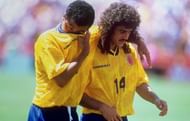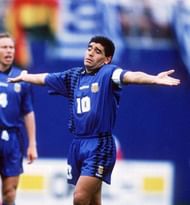The first part of this article is available here.
USA ’94 had this incredible gift of appropriate setting – a gift which not only fit the grandeur of the World Cup with the appropriate timestamp, but one which also broke new ground and created plenty of history before it was through.
This was the last World Cup to feature 24 teams. The 1998 World Cup was the debut of the 32 team format. There were six groups of four teams each, with the top two qualifying automatically. All six third place teams were then ranked against each other, with the best four of those going on to the Round of 16.
New entrants, new records, new rules
Brazil became the first country to capture four World Cup titles. They defeated Italy in the final – the first time a final had finished goalless and the first time it went to penalties.
Greece and Saudi Arabia debuted at this World Cup. Following the steady growth of African football, especially after Cameroon’s heroics at Italia ’90, the continent was granted a third spot, which saw Nigeria make their first appearance at the finals as well.
Bolivia, Norway and a very handy Switzerland side (featuring all time greats Stephane Chapuisat, Ciriaco Sforza and Marc Hottiger) managed by Roy Hodgson returned to the World Cup after long absences. Bulgaria, Morocco and Mexico featured once again on the world stage after comparatively short ones.
The Republic of Ireland made it to America under Jack Charlton but otherwise it was an unmitigated disaster for all landmass north of the English Channel.
None of England, Scotland, Wales and Northern Ireland (and Iceland, academically speaking) made it across the pond. This was the first time since 1974 that England had not made it to a World Cup. Wales hadn’t qualified since 1958, Northern Ireland hadn’t been seen since the group stages of 1986, although Scotland had been in Italy four years prior.
After a widely criticised Italia ’90, mostly due to an abundance of cards and cynicism, and a paucity of goals and excitement, FIFA responded dramatically. The back-pass privilege was scrapped in 1992, and three points were awarded for a win at USA ’94 for the first time.
A shaky start
Not that any of this did much good, though. Although partly due to revisionism, USA ’94 did not fare too much better in fans’ eyes than Italia ’90. It was felt that the 1990s had given spectators ‘the old one-two’ of disappointment after two excellent World Cups in 1982 and 1986. Matters were not helped by scatter-brained FIFA-issued directives regarding officiating. These led to plenty of inconsistent refereeing which left a bad taste in the mouth.
USA ’94, however, will hopefully not be remembered for how it disappointed some fans. It has a wealth of incredible stories to tell, and it is for them, and its position at a critical juncture in world football history that it will be remembered. Coming as it did after the widely reviled Italia ’90, it was a step in the right direction.
The tournament got off to a rather dicey start – one area where 1990 actually trumped 1994 – the aforementioned refereeing claiming its first victim in Marco Etcheverry and President Clinton roundly booed as defending champions Germany overcame intense heat and humidity to beat Bolivia 1-0, but it recovered to post the highest average attendance at a World Cup (around sixty nine thousand), a figure which has not been bettered since.
Favourites disappoint, dark horses impress
Pre-tournament favourites, when viewed through the necessary utility that is hindsight, formed a strange dichotomy with the unheralded participants, an instance that only served to enhance the excitement and unpredictability of football Stateside.
Brazil (top of Group B; who had also lost their first ever World Cup qualifying match to Bolivia) and Argentina (third in Group D) had done a complete 180 from their death-defying vintages of yesteryear, deteriorating into ‘results-first’ machines with each successive tournament.
After a meeting on June 24, 1990 at the last World Cup, a pulsating, knife edge encounter that was laced with drama and a hefty dose of the extraordinary that is impossible to convey through words, a game that threatened to go one way for eighty five minutes and eventually went the other, settled, as it was, by the incomparable genius of Diego Maradona, both teams had frustratingly reverted to the status quo.
Germany had evidently not evolved from a similar mindset after reunification. Having courted plenty of ill feeling over the previous three World Cups, over what was a dour, unimaginative brand of football as well as often violent cynicism (their rap sheet included the Patrick Battiston/Harald Schumacher incident from 1982, the farce against Austria the same year, not to mention the all-too-regular presence of Stefan Effenberg in the line-up) they nevertheless topped Group C before bowing out in the quarter finals. Needless to say, few tears were shed.
Second behind them were Spain. Oft burdened by a fatal inferiority complex in the past, compounded by an awkward tendency to overrate or underrate themselves depending on the opponent, the Spaniards appeared to have shed both this time round, improving as the tournament went on but losing to Italy in the quarter-finals in a game which is a remarkable story in itself.
Big things were expected of the flamboyant Colombians, one of the few redeeming features of Italia ’90, especially from players of the order of Freddy Rincon, Faustino Asprilla and Carlos Valderrama (everything a footballer should be and more), who featured regularly under coach Francisco Maturana.
Espousing the more ‘classic’ South American values of flair, determination and fearlessness, they were the daring rebels to seriously challenge the Brazil/Argentina hegemony of South America. Entering the World Cup following a surreal 0-5 demolition of Argentina in Buenos Aires, they were missing their eccentric but revolutionary goalkeeper Rene Higuita (for the younger readers, think Manuel Neuer, only Colombian and much shorter), who was serving a prison term for his involvement in a kidnapping.
It all went badly wrong. Beginning with a 1-3 defeat to Romania (who finished top), Colombia then lost 2-1 to the USA (who qualified in third behind Switzerland), finishing bottom of Group A, with persistent rumours of undue influence on the team by drug cartels, bookmakers and death threats.
Colombia’s exit from the tournament was disappointing, but no one could have predicted it would end in tragedy.
Salenko and Milla – and a piece of history
In Group B, Cameroon could not repeat their heroics of 1990, and crashed out dismally. But not before Roger Milla became the oldest player and goal scorer in World Cup history, achieving the latter in a curiously nondescript 1-6 defeat to Russia.
And in a deliciously satisfying coincidence, the Colombia squad at USA ’94 contained a young goalkeeper by the name of Faryd Mondragon. 20 years later in Brazil, he went on to break Roger Milla’s record and became the oldest player in World Cup history.
In the same match, Oleg Salenko became (and, as of Brazil 2014, is still) the only man to score five goals in a World Cup match. Despite Russia not making it out of the groups, he finished as the joint winner of the Golden Boot with Bulgaria’s Hristo Stoichkov.
Stoichkov’s exploits with Barcelona were the talk of Europe in the years prior to USA ’94 but Salenko is a rather more surprising character, a fairly modest striker who jetted around Europe in a career which, after all the anonymity that preceded and succeeded USA ’94, still left him more successful at a World Cup than Alfredo Di Stefano, and looking distinctly out of place on an honour roll including all time greats such as Ronaldo, Eusébio and Müller.
Group C saw South Korea almost steal what would have been two epochal results against the top two of Germany and Spain.
Trailing 2-0 to Spain in Dallas with five minutes remaining, the Koreans snatched two late goals before clawing back two more en route to a gallant 3-2 defeat against Germany at the same venue ten days later.
Diego Maradona’s international swansong
In Group D, 1990’s defeated finalists Argentina began with a bang, with one of the nation’s finest ever strikers, Gabriel Batistuta, helping himself to a hat trick.
‘Batigol’ – more of a Biblical figure than a footballer given his immense frame and physical appearance – was one striker. The other created headlines as well, but for all the wrong reasons.
Captain Diego Maradona had managed a fairly impressive return to the world stage. But after a 2-1 defeat of group topping Nigeria arrived the sensational news that he had been banned for the presence of ephedrine in his bloodstream. Argentina qualified as the best third placed team, but were dumped out in the very next round.
Maradona had been the manifestation controversy and brilliance in equal proportions during his long and storied career. Quite fitting, then, that one of the World Cup’s greatest ever players and a larger-than-life sporting personality did not leave quietly. The pendulum had to swing one way or another in 1994, and, for Maradona, it gave him an inglorious exit from a tournament that had been the greatest part of his mystique.
A shaky start had done absolutely nothing to undermine the fanfare around the opening stages of the tournament. USA ’94 actually got better the further it progressed and, most significantly, it gave us a first look at what became four of the World Cup’s greatest ever fables.



